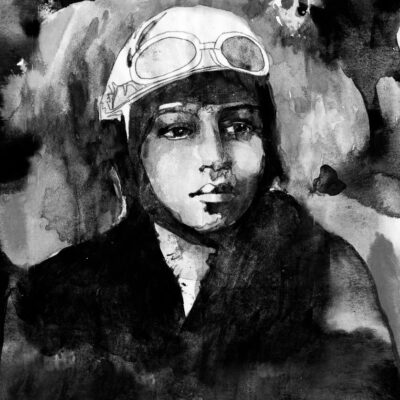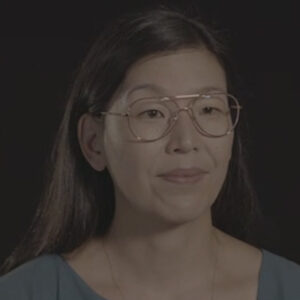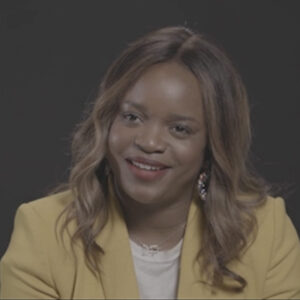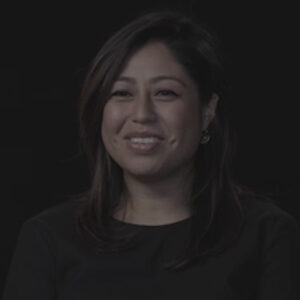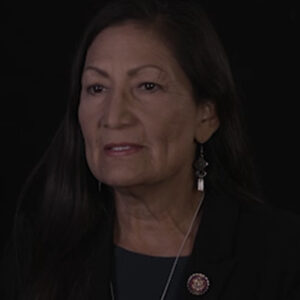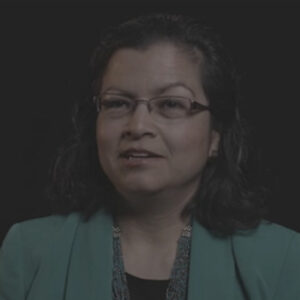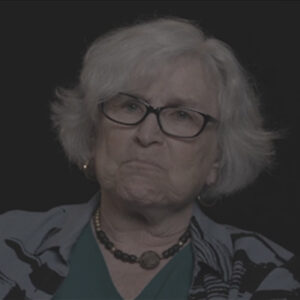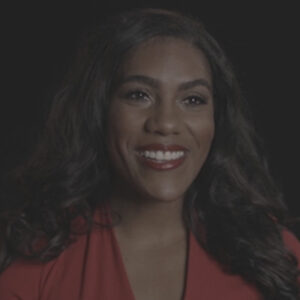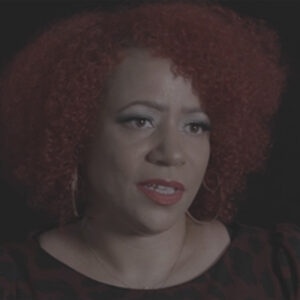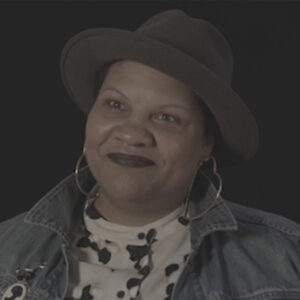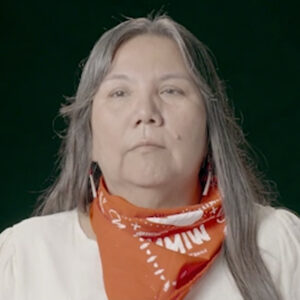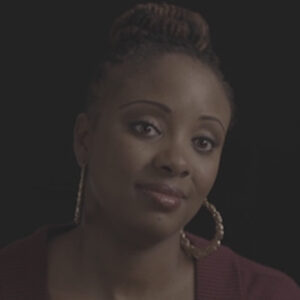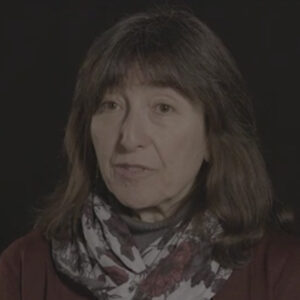Speaker My name is Jenny Reider, I am a 19th century historian for the Church of Jesus Christ of Latter day Saints. I focus on women’s history and I love what I do.
Speaker Why did you pursue this career?
Speaker You know, it took me a while to find what my passion was. And once I did, it was because I was reading some old minute books and I felt like the women’s voices were speaking to me. And I’ve been following it ever since. I realized I needed professional historian training. So I went to graduate school. I got a second masters degree in history and then a Ph.D. in American history. And I’ve been doing this ever since.
Speaker What are minute notes?
Speaker So in the 19th century, different organizations would keep minutes of their meetings and they would be bound in a in a ledger or a book of some sort. And they would record often, according to parliamentary procedure, the things that they discussed, the the lists of membership and often the donations. But the things that most excite me are the things that they discussed and the way they talked. And these particular women’s meetings gave women a chance to speak publicly in a way that they hadn’t been able to previously.
Speaker Sorry, I just one thing. There’s just this shadow looks.
Speaker These are the things I like that you adjust. Thank you.
Speaker OK, enough, is it OK? Just try to avoid it.
Speaker Yep, or you just want to put maybe I’ll put it on the floor because I do use my hands and I know they won’t show, but just how I talk. Yeah, I lived in Italy for a year and a half, so I oh, I was a missionary for my church and it was I was 21, 22 southern Italy. It was awesome.
Speaker Mm hmm.
Speaker There we go. OK, thank you. OK, so. So what challenges have you faced in your career as a.
Speaker It’s interesting to work for the Church of Jesus Christ of Latter day Saints, women don’t often have leadership positions, and I think that’s just part of a of a century of women tending to stay at home. And I think that’s changed quite a bit actually, since the early women. I think they were more involved publicly than they are today. And so I think that’s one of my challenges, is hitting sort of a glass ceiling as a woman to that. OK, and another I guess another thing that has been challenging is that I do have a Ph.D. and there aren’t a lot of women with PhDs that work where I work.
Speaker So does that provide more prestige?
Speaker It provides both more prestige, but also sometimes I think it might be threatening and that really bothers me.
Speaker And how does that manifest?
Speaker I don’t know a good way to answer that without putting anybody I know. OK, OK, OK.
Speaker Well, I guess I was going to go into that. But since you’re on that topic, I’m curious about what what life is like for women in Utah today and how they’ve changed since the area.
Speaker Where do I start to? I start with Martha’s timer today.
Speaker I guess it’s OK.
Speaker I think Martha’s time, the the late 19th century. Let me start over the late 19th century and let me start over. The second half of the 19th century was a really exciting time for Mormon women.
Speaker They were because they were living on the frontier and also because they were a polygamist. Interestingly enough, they were able to let go of some of their domestic duties and allow their sister wives to take care of that while they were able to do more public and civic and scientific and educational things and political things. So Mormon women, I think, were progressive earlier than the progressive era. And I think that’s really exciting. And that’s why I love studying that. I think a little bit of that changed when Utah became a state and when the Mormon Church and Utah both were really trying to Americanize. And as a result of that, Mormon women lost a little bit of their autonomy and their progressiveness. Today, however, I feel like it’s coming back. I feel like we have Mormon women involved in so many different public spheres in politics and education and social social.
Speaker Let me start that over. What do I want to say today?
Speaker I think Mormon women are involved in so many different ways in politics, in education, in social affairs, in civic and community affairs. And it’s a really exciting time to be a Mormon woman. I think things have changed with the way the leadership has viewed women, and I think women are much more engaged and active in even the leadership of the Mormon Church.
Speaker So some of the things that Martha Stewart can pursue, medicine and politics, or Britney Spears with the leadership of the church, encourages women to do.
Speaker Yes, some of the spheres that Martha Hughes Cavin pursued in politics and in medicine are encouraged just as much today as they were in her day.
Speaker So, you know, this project’s title is unladylike. What does that mean to you? What’s your personal definition?
Speaker I think unladylike means not your typical female mold. It’s interesting to look at how Mormon women acted in the second half of the 19th century. They both wanted to be refined and cultured and Victorian women.
Speaker And yet, on the other hand, they did things that were well beyond that sphere, if you will. That’s a very 19th century word. These separate spheres, they they expanded that sphere in many different ways. I think being unladylike means doing new things and pushing that sphere and pushing the boundaries just a little bit or a lot.
Speaker Great.
Speaker So, as you noted, our project is based on women who accomplish great things during the progressive era, which we’re defining as the 80s, 90s through the 1920s. Um, give us some briefly some background on what America was like at the time, what Utah was like at the time.
Speaker A lot, yeah, no, we’ll get there, the paragraph, the progressive era is actually a really exciting time in American history. It’s coming on the end of the gilded era and it is leading into modernism. So we have a time that follows the industrial revolution, that recognizes the implications of the industrial revolution and urbanization. Also, as a part of the industrial revolution, you get this influx of immigrants coming to America. And as a result of all of that, you have this age where people are suddenly concerned with social conditions and with political conditions and political corruption and with monopolies and antitrust associations and scientific explanations and help for social conditions. And so it’s an exciting time. It’s a time of change. I think it’s interesting because Utah is a little bit different. In one sense. They’re ahead of the progressive era because they have been proving all of these things for women in particular, and they’ve been looking at medicine and education and political activism with their suffrage movement. On the other hand, this is a very interesting time for women. It’s a time when Utah and Mormons are are transitioning from an isolated state where they were really guided by patriarchy to a time of Americanization, where they go through statehood and they go through more women’s suffrage. And they also go through this sense of of.
Speaker Hold on, let me think what I want to say.
Speaker Utah is at an interesting crux here in eighteen seventy seven, Brigham Young died and he had led such an important movement of of Mormons and moving them from the east to the west and allowing them to build their Mormon frontier, which included political and cultural restraints. And they all sort of blended into one after his death in 1877, as well as the coming of the railroad and the expansion of transportation.
Speaker With that influx of immigration, you see a totally different Utah. You see a state where women are more actively involved, a state where polygamy ends. So there’s a total shift in the social construct of family. You see a state where Utah actually does become a state and claim some of their statehood privileges and you see a state that becomes much more Americanized rather than isolated.
Speaker And so to dig into some details, what women in Utah, when I was growing up, Utah women received the right to vote in 1870.
Speaker They were actually the second state behind. Well, actually, Utah women received the right to vote in 1870.
Speaker They were the second territory that gave women suffrage. Wyoming was the first at the end of eighteen sixty nine. But Utah had the first election. And so Utah women were the first to vote. And this is a time when Martha Hughes Cannon is growing up. And she was also a typesetter for a newspaper called The Women’s Exponent, which was one of the first women’s newspapers west of the Mississippi. As a result, she was able to see firsthand the active work of women in Utah, the correspondence with national suffrage leaders and the work in Utah of women to store grain and to to manufacture silk and to do these economic endeavors that weren’t necessarily done in the East. I really think the West gave women different experiences in the sense that they are building their frontiers, their settlements from scratch. And so women were more heavily, heavily involved in that way. So I think she had an experience growing up that was different if she had grown up in the eastern United States.
Speaker And what about other rights force owning property business?
Speaker Sure. So while Mormon women practiced polygamy with their husbands, let me start that over. So, so well, about 30 percent of Mormons in Utah practice polygamy. So it’s not everybody because of that. Brigham Young actually initiated a higher Brigham Young actually initiated an easier divorce policy. Women in polygamous marriages were able to get divorces if there was anything that they were concerned about. So there were actually more divorces in Utah than there were in other places. It was much easier to get a divorce in Utah.
Speaker Um.
Speaker You touched on that already, OK, let me say one more thing about Martha growing up.
Speaker Martha grew up in a time where suffrage had been given to women in 1870, but because of federal anti polygamy legislation, women lost that right in 1882. So women were only able to vote for 12 years and that was voting only in municipal elections in local elections. After that, women became even more encouraged and enlivened to suffrage. And so Martha saw that whole growth of Utah Women’s Suffrage Association, this as a state or as a territory, but also in local legal settlements all over the territory.
Speaker We’re going to dig into her suffrage. OK, OK, so let’s move on to her. So it is much detail, as you think is pertinent. If you could go through her life story and pretend that you’re talking to.
Speaker Yes, absolutely nothing about the money, we’re just happy to give you accused along the way.
Speaker Yeah, about all the different chapters. OK, yeah, start with the verse and immigration.
Speaker Martha Hughes was born in Wales in 1857. Her parents learned about the Church of Jesus Christ of Latter day Saints in 1858 and prepared to emigrate and an 18. Her parents learned about the church in eighteen fifty eight and prepared to emigrate to Utah in 1860 when they left Wales. They had three daughters and they sailed across the ocean and then stopped to earn some money to make it all the way across the plains. One of her baby sisters died during this emigration, and they arrived in Utah in September of eighteen sixty one and her father died three days after they arrived.
Speaker How did they convert to Mormonism? Was it missionaries were being persecuted in any way for their conversion? I don’t know. Do you know? That’s what I remember reading that that was why interpreted OK.
Speaker OK, but let me tell you what I do now. Yeah.
Speaker Missionaries for the Church of Jesus Christ of Latter day Saints came to Wales quite early and the Hughes family learned about the Church of Jesus Christ and were baptized at the time. It was a new misunderstood religion and it was also a religion that was encouraging a sense of gathering. They wanted all of the members to come to Utah where they could create a stronghold. And so the Hughes family prepared to join the Latter day Saints in Utah.
Speaker So more details about how arduous their cross-country trip was. What kinds of conditions did they face? What were those wagon journeys like?
Speaker OK.
Speaker The Hughes family left Wales in eighteen fifty eight, and they crossed the ocean, which was always a treacherous journey, and arrived in New York City where they stopped to earn some money to make it all the way across the plains. They took a covered wagon and while on their journey, their mother had a baby girl who soon died.
Speaker The conditions weren’t great. They were difficult and arduous. A lot of the times the father probably walked in the mother as well as she could as well. And that was stupid.
Speaker The journey was arduous and they covered mountains and plains. They cross rivers several times. They were threatened by Native Americans and they were threatened with sickness and with a lack of food. But they made it and they arrived in September of eighteen fifty. No, they arrived in Utah Valley in September of 1861. Three days after they arrived, Mattie’s father died. He was so exhausted from the journey and he lived to see the arrival of his family there. But he didn’t live much longer. Soon after that, Maddy’s mother married a Scotsman who who was a widower and he had four children. And so all of a sudden they blended their families together. And that’s how Maddy grew up. They didn’t have a lot of money and she had to work quite a bit of her early life.
Speaker How did the death of her sister and father impact?
Speaker Mattie saw her baby sister die. She saw her father die three days after they arrived in Salt Lake City. And she saw in the early settlement of Utah, many women and children die. And I think this was a huge influence on her decision to become a doctor. She knew that there had to be more, that they could do, more training that they could receive and more medical care that they could give.
Speaker So we’ll see what kinds of jobs did she do early on?
Speaker And then, of course, at 14, as you mentioned, she starts to work for the. Women’s exponent, can you tell me? Yes.
Speaker Mattie works to support her family in many different ways at age 14. She actually taught school, which I think is such a young age to teach school. At age 15, she started working as a typesetter for the Deseret News and then for the women’s exponent. She even typeset a Scandinavian newspaper when she didn’t know the language. And there are stories of her having to walk through the muddy streets to get to work. And so she would roll up her skirts so they didn’t get muddy. She was pretty much a tomboy, as well as a provider for her family.
Speaker We’re in men’s boots, right? Yes.
Speaker Yes, yes, I can tell as a young girl, she will not let me don’t let me not say that as a teenager, she walked to work in the muddy streets of Salt Lake City. She would wear men’s boots and tuck up her skirt into her waist so she didn’t get muddy and was a typesetter, the typesetter.
Speaker OK, the press required.
Speaker OK, OK. Press technology at that time require that each letter be typeset, each letter be set in a row to form the words.
Speaker And so it took a lot of tedious work and that’s what they often hired younger girls to do. Matty was one of those and as a result of her work, she gained insight into the press, insight into what was going on, current events and also relationships with some of the leading people of Utah.
Speaker So what was the woman’s exponent kinds of mentors towards the women’s exponent was an incredible women’s newspaper.
Speaker It started in 1871 under the direction of Lulu Green. After Lula got married, Emmeline Wells took over as the editor. This was a women’s newspaper, one of the first west of the Mississippi. It was written, edited, typeset and published and distributed by women. And it was a place where women could share their thoughts through editorials. They could share their life stories through reminiscences or through autobiographies. They could share correspondence with women in the East, particularly regarding suffrage and other things. And they could even share their own correspondence as they went on missions with their husbands to French Polynesia or to Europe. They sent in reports from all over the territory, from Arizona and Idaho and Colorado. And so it gave them a much broader spectrum. They lived in a larger world than just their tiny town because of the women’s exponent. It showed them what other women in the territory were doing in regards to grain storage or to the manufacture of silk or to education or to medicine. And it put them all on the same plane.
Speaker And am I correct that it’s in its pages, the refugees first discovers the University of Pennsylvania? No, not in Michigan.
Speaker Michigan is opening its I’m not sure, but I do know this, that in the pages of the women’s exponent, Martha Hughes was able to see other women going east to the University of Michigan and the University of Pennsylvania, people like Romania, Pratt and people like Romania, Pratt and Ellen Ferguson, people that she looked up to and that she saw that spark of an idea and knew that that’s what she wanted to do.
Speaker As a result, she went to the University of Deser at a college there in Salt Lake City. She got a bachelor’s degree in chemistry. And then later, Ellen Ferguson, who was one of those doctors who had gone back east.
Speaker And then later, Romania. Pratt, who was one of those doctors who had gone back east to get her medical degree, helped Martha raise money to go for herself.
Speaker So you actually referred to her as Maggie?
Speaker Yes. So Martha is her official name and she often goes by Madie, which is her nickname.
Speaker Mm hmm. So was the church leadership and the other men in her life like her stepfather supported. I don’t to get an education.
Speaker I don’t know about her stepfather, but we do know that Brigham Young felt very strongly about women becoming doctors. He recognized the importance of women’s health, and he knew that it would be more comfortable for women to have female doctors, especially with their particular health issues. And so he was the first person to send women back east to medical school. He was a strong proponent of that. He also encouraged these women that went to medical school to come back and start classes where they could teach women in Utah these skills in midwifery and in nursing. Mattie actually started the first school in nursing in Salt Lake City. So they would bring in women from every settlement to these classes and they would as a result, as or as payment, they would send them back to their settlement to act as midwife or nurse in that settlement.
Speaker So tell me about her studies at the University of Michigan. OK. And was sort of provide context for what it was like to be a woman, OK, in a university at the time. Was it common, was it rare? OK.
Speaker OK, in eighteen seventy eight a year after Brigham Young died, Martha was set apart, actually, she was appointed by the next prophet, John Taylor, to go to medical school. She went to the University of Michigan. Let me start over. I feel like I’m stumbling.
Speaker Hold on. Some great little details. I know that’s where.
Speaker Brigham Young passed away in eighteen seventy seven. His predecessor, John Taylor, also encouraged women to go to medical school. In fact, he assigned and appointed Mattie to go to medical school. She followed in the footsteps of women such as Romania, Pratt and Ellis Shipp and Maggie Shipp, and he commissioned her to do that.
Speaker So she went to Michigan, which was a place that obviously had accepted women into their program. She graduated two years later on her birthday, and she later pursued other courses in pharmacology and in surgery. She also got a degree in oratory, which I love. So she actually performed some surgeries in the East Coast.
Speaker And one of them, I have to get the right word.
Speaker She also performed surgeries on the East Coast, one of them was on a vaginal fistula and she was the charge doctor. Now, she had a second doctor appointed to help her, who was a man, and he refused to work under a woman, which is fascinating. She later became a surgeon back in Utah at the Deseret Hospital.
Speaker In 1882, she became in 1882, she was appointed the head surgeon of the Deseret Hospital following the resignation of Alan Ferguson.
Speaker What was the decision of the Deseret Hospital? Was a hospital coordinated? And let me start over.
Speaker Women in Utah soon realized that they needed a space and actual space where they could practice medicine and care for women, and so they had plans and figured out how they were going to raise the money for it and created the Deseret Hospital, which was started in 1882. This hospital had a female board of directors and female doctors and female nurses. It created a place where women could serve each other and care for each other. So in 1882, Martha Hughes became the head surgeon following the resignation of Ellen Ferguson.
Speaker Just quickly, going back to her postgraduate studies, I read that she was OK. OK, let me say that you and I often have to sit apart. OK, so she would be a distraction to them?
Speaker Well, in graduate school, Maddy was often the only woman in her class, a class of seventy nine. And often they asked her to sit apart from the men in order to not distract them. But she did. And she passed with flying colors and she became a very successful graduate was actually seventy five. OK, let’s say that again, Maddy was often the only female in her class, a class of seventy five. She was often asked to sit apart from the men so as not to distract them. And she just leaned into her own studies and did not let that figure into her graduate school experience.
Speaker Create, um. What did she do in between prep for graduation and and the Deseret Hospital opening or did she go straight?
Speaker No, she didn’t.
Speaker Did she have a private practice? OK, listen, let me tell you just a second. Let me read this. OK, in 1881, Maddie graduated from the University of Michigan Medical School, and for a period she practiced medicine in Michigan.
Speaker She had U.S. and Canadian patients and then she was accepted into sort of an auxiliary medical program at the University of Pennsylvania. It was here that she was the only female in a class of seventy five, and she was often asked to sit apart from her male counterparts so as not to distract them, which she did. And she dug in and learned everything that she could. She also stirred. She also studied pharmacology at this time.
Speaker And was pharmacology a.
Speaker A burgeoning field of study.
Speaker I don’t know, you know, OK, but at the same. OK, let me hold on.
Speaker At the same time, this is a woman who’s able to juggle a lot of different loads from 1881 to 1880 to she studied at the National School of Oratory in Philadelphia.
Speaker Yeah, let me say that without looking down.
Speaker At the same time, Maddy Hughes studied at the National School of Oratory in Philadelphia from 1881 to 1882. I love that she combined these two studies of medicine, of pharmacology, of surgery and of oratory. She wanted to be able to perform medicine to the best of her ability, but she also wanted to be able to deliver lectures and to teach others. And she felt that that course would really perfect her skills later.
Speaker Let me do that. I know. I want to say that she felt that the skill of oratory would enable her to deliver lectures on medicine, to teach courses on medicine. And later, the skill also helped her to practice.
Speaker And later, the skill also helped her to participate in the Utah legislature to give speeches on the floor and to encourage.
Speaker And to encourage good health and politics for women.
Speaker So tell me the story of her meeting Angus Monarchial about this time their age difference. Mm hmm. Who was he?
Speaker OK, Maddy Hughes became the house physician at the desert hospital in 1882, Angus Cadden was a member of the board of directors at this time.
Speaker And one day she was scrubbing the porch and the floors and cleaning the hospital.
Speaker And he came up the front steps and wanted to go inside the hospital to do some work. But she wouldn’t let him because she was cleaning the porch. And I love that story. I think it shows a little bit of her feistiness and her commitment to the job that she was pursuing at the time she later married Helen.
Speaker OK, on October 6th, 1880, for Martha Hughes, married Angus Cannon, he was a prominent church leader. He was twenty three years older than she was and she was married to him as his fourth wife.
Speaker And my understanding is that the marriage had to be secret. She even hid it from her parents.
Speaker Oh, gosh.
Speaker Why was that OK?
Speaker Plural marriage at this time was a tricky thing for Mormons, while they firmly proclaimed their right to religious freedom and their right to practice their religion according to the dictates of their own conscience. At the same time, federal legislation was working against plural marriage in 1880 to the Edmund Tucker in 1880 to the Edmands Tucker Act, removed suffrage from women, all women in Utah and put serious repercussions on all those who were practicing polygamy as a result, Matti’s. As a result, Matti’s marriage had to be practiced in secret and as a result, Matti’s marriage was performed secretly and she couldn’t even tell her parents about what was going on to occur with 1887.
Speaker It what’s in 1882 is the column. OK, ok, let’s get that good comes back.
Speaker OK, thank you. Let’s say it right in eighteen eighty two federal legislation passed the Ed thank you in 1880 to the Edmans bill was passed or shall I say Edmund’s act was passed in 1880 to the Edmands act was passed and made a bill and it prevented any women in Utah from voting no matter if they were Mormon or non Mormon, plural wives or monogamous wives.
Speaker It also put serious pressure on those who practice plural marriage. As a result, when Maddie was married in nineteen eighty four, she had to do so in secret. She couldn’t even tell her parents that she was marrying Angus Cannon. He was a prominent Mormon leader and twenty three years older than she was, and she was marrying him as his fourth wife.
Speaker Tell me briefly how important oh, boy, OK, the practice of plural marriage started actually with Joseph Smith in the 18 thirties. It was a practice that developed in the 18 40s. And he he viewed it as a revelation from God, as a restoration of the early church, a church where people in the Old Testament practiced polygamy.
Speaker And he did it as a means of creating these kin networks where families were sealed together in a sense of connection to the priesthood. And so often people would steal their daughters to him in hopes of sealing their families together.
Speaker Interestingly enough, there were no children or offspring from any of Joseph’s plural marriages. And this was a practice that was kept secret or sacred in the eighteen forties and Nabu. When Brigham Young took the Latter day Saints across the plains to Utah in 1850, to the practice became public and Brigham Young and others had several wives they were able to incorporate. The men in 1850 to Brigham Young made the practice of polygamy public and it was widely discussed and widely expressed. While only 30 percent of the population in Utah actually practiced polygamy, the news of it and the publicity of it became much bigger and a concern to those in the east who held on to Victorian standards of womanhood and a family. And it became a problem for Utah and for Mormons.
Speaker So how did these federal sorry, so so this law was passed to to try to outlaw polygamy and then there are federal raids to crack down.
Speaker Mm hmm.
Speaker Just does all of that impact.
Speaker And I guess this anti polygamy legislation had a specific influence on Martha Hughes Cannon. Her plural marriage was a danger, actually, to the Deseret Hospital. There is concern and fear that her patients would be required to testify against her and against Aengus in 1880. In eighteen eighty five in January, Angus was actually arrested on charges of cohabitation and as a result of this, Martha Hughes Cannon had to go into hiding. She didn’t want to testify against her husband. And the way that she and many of these other women saw to counter this was to go into hiding or what was known as the underground.
Speaker Martha actually had her first child, her first baby girl away from her husband in Grantsville, Utah, and soon she was moved to other places in Utah. I don’t want to say that.
Speaker In order to not testify in January of 18, in January of eighteen eighty five, Angus was called was OK.
Speaker In January of eighteen eighty five, Angus was charged with unlawful cohabitation. Martha, his fourth wife, refused to testify at his trial and she later traveled around. She went to a convention in New Orleans. She went to other places in the United States to sort of avoid being there in Utah. She was also pregnant with her first child and she had that baby girl in Grantsville, Utah, and she later moved to Centerville, Utah.
Speaker So she was trying to stay away from her husband and away from federal officials who were seeking her out in order for her to testify against her husband and thus sent him to prison.
Speaker What ended up happening to hold on?
Speaker I want to say one more thing.
Speaker So during this time, she visited a cotton exposition in New Orleans. She went and observed schools in Boston and in New York City. And she came back with a better idea of how medicine and women and other things were handled outside of Utah.
Speaker She OK, that’s good. No, no, no. I want to say that again.
Speaker She inspected training schools for nurses in New York City and Boston and had a better idea of how other people in the East Coast conducted such courses.
Speaker Yes, it’s never not working, right?
Speaker No. OK.
Speaker Her husband following Angus’s trial on April twenty seventh, he was sentenced to six months in federal prison, and that is when Maddy went abroad. She went to other place. No, I don’t want to say that she didn’t necessarily go abroad.
Speaker I’ll just leave it at that and tell me a little more about this woman underground. Many people I don’t.
Speaker So historians term what they call the Mormon underground during this period where people were in hiding. That was both men and women. John Taylor, the president of the church, was on the underground. But there are also many women, many plural wives who are on the underground and who sort of moved from place to place. Some of them didn’t tell their children who their father was so their children wouldn’t slip up. Some of them took assumed names. Some of them lived in really harsh, difficult circumstances. While on the underground, they were afraid of federal raids on the town. They didn’t want their neighbors to give them away or deputies to give them away. And so they really had to live a secret life.
Speaker So much I know.
Speaker Were these federal raids, the federal raids occurred when deputies got word of either a man in plural marriage or a wife and plural marriage.
Speaker They were trying to pursue the persecution of plural marriage. And so they would either take the man in to trial and hope that the the plural wives would testify against them and then put them in a federal prison.
Speaker She talked about her going to Britain. Yes. OK, tell me about her exile. Yes. Hmm. Yes.
Speaker Well, in hiding, Harry Pattiz, my great grandmother’s name. Oh, well, in. Well, in hiding. Maddie could have stayed in Utah and remained on the underground. However, she had a sick daughter and she knew she needed to give her more careful attention. In April of eighteen eighty six, she decided to go to Britain in order to live a more open life and to care for her daughter. While she was gone, her husband Angus, married a fifth wife.
Speaker Maddie traveled around Europe. She observed different hospitals and nursing schools.
Speaker She continued to work towards her career and her education and raise her daughter. She also took care of stepson’s sons of other wives that had been sent away on missions so they, too, wouldn’t have to testify against their father. And so she helped them as they headed into Europe on their missions.
Speaker Do you know why she chose Britain? No shame on her relatives?
Speaker No.
Speaker No, because she was in Britain, not Wales at the time that she spent in Britain was close to her hometown of well, or the time that Maddy spent in Britain was close to her homeland of Wales. But she left Wales as such a young child that she didn’t have any connections back there. She lived with a family in Britain but hid her identity as a plural wife. While she was there, she also suffered from poor health.
Speaker She adopted a fake name. Mm hmm.
Speaker Yeah, while in England, she lived with several and several while in England she lived in several different situations. She lived with a family and adopted a fake name. She also lived with other plural wives that had been exiled to England when she herself suffered from poor health. And it was a hard time for her with her young baby. She was unable to practice medicine in Britain because of her situation. But she she was unable to practice medicine in Britain because of her situation, but she did often give medical lectures on pediatrics. She was unable to practice medicine in Britain, but she hasn’t.
Speaker She was.
Speaker She was unable to practice medicine in Britain, but she did give lectures on obstetrics.
Speaker So she returns to the US, but the repression against Mormons is small swing. What was her return to Salt Lake City like?
Speaker OK, so I have in my notes, OK, she OK, Martha Hughes can return to Salt Lake City in 1888 and she started the first nursing class for women. It was a hard time, though, for her. She also practiced midwifery and she had the fastest horse that she could find so that she could get to women who were in labor as quickly as she could. One time, however, her horse was going so fast that it tipped over and it actually caused a miscarriage in her.
Speaker And so she suffered from that. She ended up having to leave Utah and go to California. She went to San Francisco, where she studied other medical topics.
Speaker I don’t know that she became so discouraged in her marriage and in her hiding that she went to San Francisco for a time of exile.
Speaker Because he even takes a six. Yeah, tell me about that and how his opinion of polygamy evolves in the course of.
Speaker Well, Martha Hughes Cannon was in England. She traveled around Europe. She visited several hospitals in Switzerland and France and Germany. She suffered from poor health, as did her baby. But she also learned through letters always written in code names and with coded words that her husband, Angus, had taken both a fifth wife and then later a sixth wife.
Speaker Martha returned to Utah and eighteen eighty eight, where she wanted to practice medicine. And she did. She started a nurse’s class, the first nurse’s class in Utah. She also delivered babies and had the fastest horse she could find to get her to those laborers as quickly as she could. Unfortunately, when one of those quick laborers, her carriage tipped over and caused a miscarriage, she was very discouraged in her marriage. She was not receiving the attention she wanted from her husband.
Speaker She wasn’t able to live openly as a wife with her children. And as a result of that, she went to California, to San Francisco and lived in exile for a short time.
Speaker Before they ever able to actually live together under the same roof, I don’t know the answer.
Speaker I don’t know the answer to that either. There’s a question in my mind. Yeah. So so then things start to shift because of the manifest. Yeah, let me. Yes, yes. No, you know, but it’s after the manifesto, so this is perfect.
Speaker In 1890, the president of the church at the time was Wilford Woodruff, and he began to realize the heavy burden of all the federal legislation. The Church of Jesus Christ lost a lot of their property and their money as a result of that. And he knew that they would never, ever be able to become a state. This was a severe political challenge for Utah and for all those that lived there. As a result, he prayed desperately and received revelation from God that it was time to end the policy of plural marriage. This changed a lot of things for a lot of people. Men, though, had a hard time deciding how they were going to balance their marriages and still take care of their plural wives while not performing any additional plural marriages. In eighteen ninety one, Maggie came back to Utah. She started a new practice of women’s health and also nervous disorders, and she became involved in the suffrage movement. Suffrage still had not been given back to Utah, to Utah women, and she became involved in the Utah Women’s Suffrage Association. It wasn’t until Utah became a state in 1896. In eighteen ninety five, they were writing their state constitution in preparation for that. And part of that state constitution gave women the right to vote. And it was a very exciting time for all the suffrage workers and also for Martha Hughes canon.
Speaker Can you specifically mentioned the manifesto?
Speaker Oh, I’m sorry, sir. That’s I think it will probably show it right.
Speaker OK.
Speaker In 1890, Wilford Woodruff received revelation from God that it was time to change the practice and the policy of plural marriage. He issued what is known as the manifesto, which ended the practice of plural marriage for the Church of Jesus Christ of Latter day Saints.
Speaker And is that still the official policy?
Speaker And yet does continue to be practiced by certain? Yes.
Speaker Yes, the practice of plural marriage ended for the official Church of Jesus Christ of Latter day Saints in 1890 and remains the practice today, the policy today. Several offshoots, however, call themselves the fundamental Latter-Day Saints continue to practice plural marriage. They are separate from the Church of Jesus Christ of Latter day Saints, and they practice and in their own way, that was ended.
Speaker I feel like I ended with a weird tone.
Speaker The practice of monogamy remains in force for the Church of Jesus Christ of Latter day Saints today. However, almost immediately after 1890, there were several fundamentalist groups of Latter day Saints that continue to practice polygamy. And even today, they practice polygamy in several different breakoff groups all over the western United States and Mexico.
Speaker Yes, based on my experience, which is actually that takes away it sorry, no, OK, we got this. And once again, OK, just steps up to the person to do.
Speaker Yep. Thank you. I don’t want to get this wrong, so thank you. Edmands act in 1882. Edmans Tucker act in 1887.
Speaker OK, in 1887, while Martha Hughes Cannon was in exile in England, the Edmans Tucker Act was passed in the United States. This act actually removed suffrage from all women living in Utah, whether they were plural wives or not. It also removed suffrage from any man practicing polygamy. After this, Utah women became even more engaged in the fight for suffrage. They had already become acquainted with Elizabeth Cady Stanton and Susan B. Anthony, who had visited Utah in 1870. When they maintained these relationships, they became involved in the National Women’s Suffrage Association. And in Utah, they developed the Utah Women’s Suffrage Association with branches of that association in nearly every settlement. So when Madhusoodanan returned from Britain, she became actively involved in the Utah Women’s Suffrage Association and the suffrage movement.
Speaker So her big moment in that regard is the speech she makes with the Chicago World’s Fair tonight.
Speaker Mm hmm.
Speaker Yes, eighteen ninety three was a propitious year for Utah women leading up to that. They had become involved.
Speaker Leading up to that, they had become involved in the National Women’s Suffrage Association, but they’d also become involved with the National Council of Women and the preparation for the Chicago World’s Fair. This was a huge event and this was a marking. This was a huge event and it was a mark. And I don’t want to say that the Chicago World’s Fair was a significant event and marked a turning point from the gilded era and the industrial age to a progressive era and to a modern age. And Utah women were heavily involved. It’s this first.
Speaker The Chicago World’s Fair gave Utah women the opportunity and the desire to combine both Mormon women with non Mormon women and represent Utah in the women’s building and with the Utah with the women’s commission in Chicago as part of that effort. Matt Maty is part of that effort. Martha Hughes Cannon was involved in several different conferences that were a part of the Chicago World’s Fair, and she gave a very significant speech on women’s suffrage.
Speaker This is interesting because the Utah women had been so involved with women on the East Coast before the World’s Fair and Utah men had been so involved in Utah politics and settlement, Utah women were much more readily accepted and active in Chicago in 1893, where Utah men were denied the privilege of participating in many of their conferences and Congresses.
Speaker Interesting point, you already touched on this, but tell me again about Utah achieving statehood in 1896.
Speaker Yeah, women’s suffrage being written into the Constitution and did not play any significant role.
Speaker I don’t know if she did, you know, OK. Eighteen ninety five in 1896 were significant for Utah history. They had applied several times before that to become a state in the United States of America. But it wasn’t until eighteen ninety six when that was actually granted January of eighteen ninety six, eighteen ninety five. Utah spent a lot of time trading in nineteen ninety five. Utah spent. I don’t even want to say Utah. I want to say the people in Utah in nineteen ninety five, the people in Utah spent a lot of time carefully crafting a state constitution and as part of that constitution they made sure that women were given the right to vote automatically. When Utah became a state that was a significant event. Utah became a state in January of eighteen ninety six and therefore women could vote in the eighteen ninety six elections November of 82. I don’t want to go that far. Does that sound OK?
Speaker Just to put it in context, what is the third state to do?
Speaker So there’s Oregon and Oregon.
Speaker OK, just to put that into sort of a national context. Utah is the third state that’s given women the right to vote following Wyoming and Oregon.
Speaker So that same year, Maddy runs for office.
Speaker OK, I want to give a little historical context on that, but I’m not going to be able to do this. Can you just do this as a voice over or do you want me to not look down? Let me memorize it real quick.
Speaker It can be a voice over. We’re going to be cutting away, OK? Right. Archive and these animations that were created.
Speaker I know. That’s why I thought maybe this part you could cover over, because I’m not going to be able to get this all right. Without looking at it.
Speaker You’re to be on camera, right? Yeah.
Speaker Eighteen eighty six was an interesting year for elections in the United States of America, the presidential election of William Jennings Bryant, there was a black man who is running for the state legislature but lost two women, won seats in the Utah House of Representatives. Colorado also had two elected in 1894. That sounds weird because I thought I’m not going to say that. Let’s not do that. Eighteen ninety six was a significant year of elections in the United States of America. So that doesn’t sound it doesn’t flow well. Eighteen ninety six was a significant year for elections in the United States of America. It was the year that William Jennings Bryan conducted his presidential campaign. A black man ran for state legislature but lost to women in Utah. We’re seated in the arena where there’s just one woman, but two women ran, three women, one one senator.
Speaker It was, oh, two women in the other house, the representative state House of Representatives.
Speaker Yeah. So it’s not that famous photo. There’s actually three. Oh right. OK, OK.
Speaker Let’s say that smoothly.
Speaker Eighteen ninety six was a significant year for elections all across the United States. This was the year that William Jennings Bryan ran for president. In another state, a black man ran for state legislature but lost. And in Utah, three women won their state elections in the Utah legislature, two in the Utah Senate and won in the Utah House of Representatives. In Utah, three women won seats in the Utah legislature, two in the House of Representatives and one in the Senate.
Speaker She was the Senate and Madhusoodanan was the first female state senator elected.
Speaker That so did stupid and better in America.
Speaker Yeah.
Speaker Hughes Cannon was the first woman elected to a state Senate in the United States of America. She served two terms and conducted significant business.
Speaker So just taking a step back, tell me about her election campaign. OK, so being on the ballot.
Speaker I know they were technically running against. Right, right. He was a Democrat. He is a Republican. Was it an unusual turn?
Speaker Yes. The eighteen ninety six Utah legislature or Utah Senate election was very interesting. There were five seats that were at large and there were between eight and 10 people running for those five seats. Madhusoodanan was running as a Democrat. Her husband, interestingly enough, was running as a Republican. Another woman running as a Republican was Murtha’s.
Speaker I want to start I want to say, Martha, she was kenen right there. And then Madie, OK.
Speaker The eighteen ninety six Utah legislative election was a fascinating one. There were five seats at large in the Utah Senate and between eight and 10 people running for those five seats. Those seats were given to the five who gave gained the most votes.
Speaker Martha Hughes Cannon was running as a Democrat against her husband, Angus Cannon, who is running as a Republican. It’s not they weren’t running against each other on the same.
Speaker Yeah, yeah, that’s right. You can see their names.
Speaker Martha Hughes Cannon was running as a Democrat. Her husband, Angus Cannon, was running as a Republican. And Matty’s mentor, Emeline B. Wells was running as a Republican.
Speaker So all of these names were on the ballot and whoever all of these names were on the ballot and the five with the highest numbers of votes, whether they were Republican or Democrat, were elected to the state Senate.
Speaker Interestingly enough, all Democrats won that election. No, interestingly enough, Democrats won the most votes, and so all five seats were given to Democrats, which means that Martha Hughes Cannon defeated her husband in the election for the Utah state Senate.
Speaker You know, I’ve seen several different reactions. I’ve heard that he was very upset. He was later released as the stake president in Salt Lake City, which was a significant calling.
Speaker And up to that point, that appointment had been an appointment for life. And so these two things happened at the same time and it was defeating to him. On the other hand, I’ve heard that Martha and her husband, Angus, publicly declared that there were no hard feelings between the two of them. So there’s a variety of reactions, I think, depending on who you talk to and depending on what your sources are.
Speaker Excellent.
Speaker Um, and I read that there was very high voter turnout in that election and specifically of of women and more men and women.
Speaker Do you happen to.
Speaker I would say this is also a significant election in Utah because obviously women were voting for the first time in a long time. And so we have a large voter turnout, particularly a large female voter turnout. It’s an exciting time for them to be able to vote once more.
Speaker So what was the candidate’s focus once in the legislature? Well, some of the policies, certain laws that she passed through.
Speaker Martha Hughes can and introduce bills to the Utah state legislature that continue to influence Utah.
Speaker Today, she introduced she acted Perdue.
Speaker She acted to protect. Now she created X. Now she acted to protect, OK, she acted to protect the health of women and of employees, which was very progressive at that time, and a certainly marked point of the progressive era. She worked hard to protect the health of both women and employees, which were progressive acts during this time, she wanted to provide seats for Utah women who were working. She created she helped create the first State Department of Health and she served on that board of health to stimulate and encourage local boards of health.
Speaker She also worked to improve sanitary and health conditions to make sure there was clean water and that doctors and nurses had official certification.

